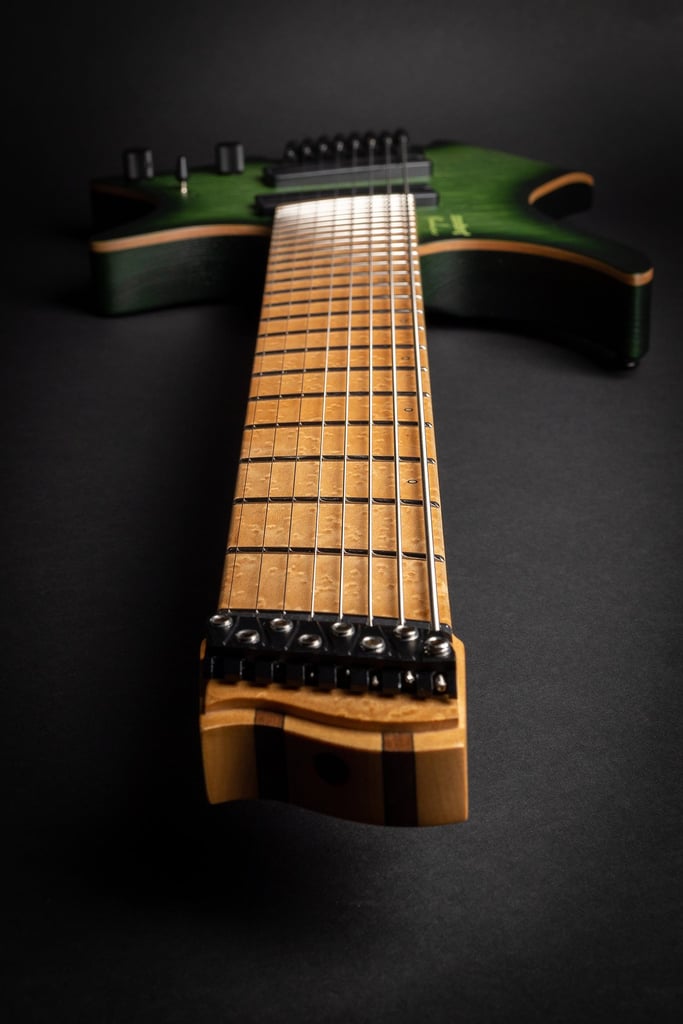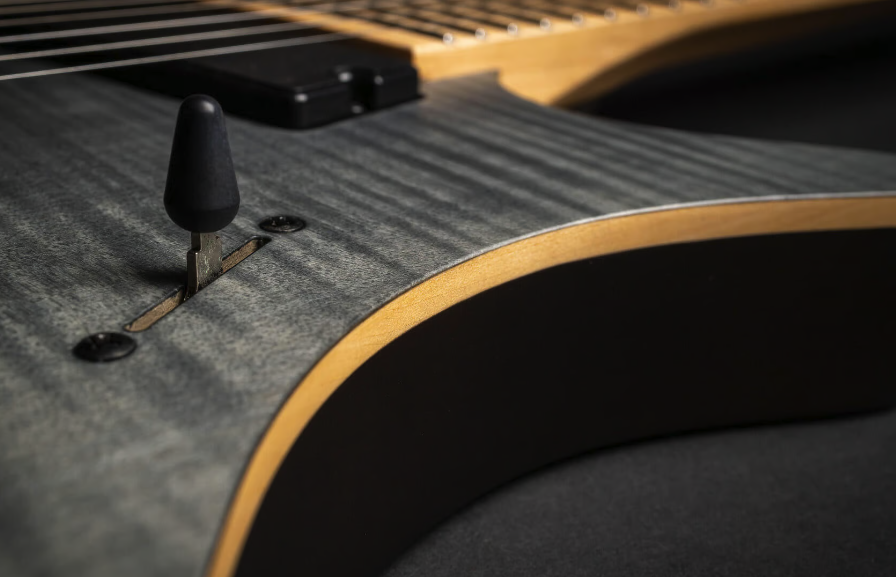We often get asked about tunings for 7- and 8-string guitars, and even though there are many possible ways to tune them, some are more common than others. In this guide, we’ll discuss the benefits and challenges of different tunings, string configurations, and also let some artists share their tips and thoughts.
Here you will learn more about:
- 7- and 8-string guitar tunings
- 4 reasons to make the switch to more strings
- Challenges with 7- and 8-string guitars
- Benefits with .strandberg* 7- and 8-string guitars
- Thoughts and tips from 3 .strandberg* artists
- Links to other guides and support functions

7- and 8-string guitar tunings with .strandberg* guitars
Since this article focuses on extended-range guitars, we’ll go through the 3 most common tunings for both 7- and 8-string guitars, and then discuss common usage in terms of styles and genres.
7-string tunings
There are several different tunings that are popular among 7-string guitar players, but the most common ones are:
- Standard Tuning
- Drop-A Tuning
- All Fourths Tuning
Standard Tuning: B-E-A-D-G-B-E
This is the most common tuning for seven-string guitars, essentially extending the standard six-string guitar tuning by adding a lower B-string. This tuning gives access to 5 additional notes below the E2 of a 6-string guitar tuned to E-standard without altering the pitch or fretboard layout of the first 6 strings.
This makes it popular in heavier styles of music, but also among musicians in various genres who need to cover a wide range of notes without changing tuning or instrument.
This tuning is the ideal introduction to 7-string guitars as it preserves most of the basic guitar note layout while adding an additional string. It also preserves familiar chord shapes, and scale patterns to ease the transition.
Drop A Tuning: A-E-A-D-G-B-E
In this tuning, the low B-string is tuned down a whole step to an A, providing the equivalent to the Drop-D tuning on a 6-string guitar, which has been popular for decades. This tuning facilitates easier fingering for power chords on the lowest strings as well as an even greater tonal range overall which has grown in popularity in recent years.
It’s also the preferred tuning by .strandberg* artist Connor Kaminski, who said that:
“You still get your regular six-string guitar, but get access to really easy power chords, and the drop chord shapes. You get this access in a really helpful way.”
All Fourths Tuning: B-E-A-D-G-C-F
This tuning refers to the intervals between each string rather than the pitch but is most commonly used as a variation of Standard tuning. This tuning alters the intervals between all strings to perfect fourths, unlike the standard tuning which features a major third between the G- and B-strings.
This creates a uniform intervallic relationship across all the strings, which some players find simplifies the fretboard and enhances the ability to play complex chords and scales.

8-string tunings
There are several different tunings that are popular among 8-string guitar players, but the most common ones are:
- Standard tuning
- Drop-E tuning
Standard Tuning: F#-B-E-A-D-G-B-E
This is the most common tuning for 8-string guitars, extending the standard 6-string guitar tuning by an added low B (same as with 7-string guitar) and a low F# to create a tonal range from F#1 to E6 depending on the number of frets.
It maintains the same relative note intervals as a standard 6-string, which makes it familiar for players transitioning to an 8-string guitar.
Drop-E Tuning: E-B-E-A-D-G-B-E
This tuning drops the lowest string in Standard 8-string tuning down from a F# to an E, which again, is the equivalent of Drop-D tuning on a 6-string guitar and Drop-A tuning on a 7-string guitar.
This tuning is popular in progressive metal as well as other genres where even lower notes and/or greater tonal range are desired.
Tunings for different genres
Even though extended-range guitars are used in many genres, the most common ones are jazz, different variations of metal, and classical guitar.
Most of the time for metal and rock, focus is put on the heaviness of sound. Therefore, many guitar players choose the Standard or Drop-A tuning for 7-string guitars and Standard or Drop-E tuning for 8-string guitars.
Jazz players who play extended-range guitars tend to stick to the standard tuning for both 7- and 8-string guitars, as do progressive rock players. However, there are no rules and the tuning used should be selected to inspire and make playing as much fun as possible.

Why choosing a 7- or 8-string guitar?
We covered this as a theme in itself in a bigger article, but if you want the short version, stick around and just continue to read here.
There are probably as many reasons to switch to 7- or 8-string guitars as there are guitar players, and many players also tend to choose a type of guitar on account of musical influences.
Simon Girard of Beyond Creation, who chose a 7-string and then an 8-string after hearing Beneath the Massacre, or Connor Kaminski who opted for a 7-string guitar after hearing Dream Theater.
However, there are also 3 slightly more objective reasons to make the switch from a 6-string guitar to a 7- or 8-string guitar that transcends genres and sound preferences.
- Greater tonal range
- Easier access to notes in all positions
- Exploring new musical ground
1. Greater tonal range
A 7- or 8-string guitar allows musicians to access a wider range of notes for creative use in composition or performance. It’s not the same as using them all the time, but in the same way as with a wide-range instrument like Piano, the creative possibilities are vast.
2. Easier access to notes in all positions
On account of the additional strings, any chosen position will give easier access to a wider range of notes with less finger stretching while playing complex chords and melody lines.
3. Exploring new musical ground
7- and 8-string guitars are essential for many progressive genres of music, facilitating intricate riffs and complex chords. These guitars are indispensable for musicians exploring new musical realms.

Challenges with 7- and 8-string guitars
Many players find it challenging to start playing extended-range guitars and while that is true, it’s also true that with some practice and habit, you will tackle these challenges quite easily. In any case, we want you to be well-prepared for the challenges (and benefits!) ahead.
- Ergonomic and physical challenges
- Technical adaptations
- Equipment and tonal integration
1. Ergonomic and physical challenges
The necks of 7- and 8-string guitars are naturally wider than their 6-string siblings, which require more strength and energy to maneuver the entire neck and fretboard. The larger size of the instrument can be experienced as physically demanding, particularly during extended sessions or complex musical passages.
2. Technical adaptations
Additional strings and notes add complexity to fretboard navigation and demand considerable practice in mastering the new possibilities. Techniques such as picking, strumming, and sweeping also need to be adapted or relearned to effectively use the extra strings and manage the wider fretboard.
3. Equipment and tonal integration
The added tonal range creates sonic challenges in composition and tone shaping to interact well with other instruments. Composing with fewer tonal barriers means that more attention needs to be directed to musical arrangement while your signal chain may also find it difficult to cope with such a wide variety of sounds and notes.

Benefits with Strandberg 7- and 8-string guitars
Besides the benefits that some players might experience, there are also some benefits that our own .strandberg* community like to advocate. All of which are made to increase ergonomics and make playing more fun.
- Different center of gravity
- Patented Endurneck profile
- Lighter weight
Different center of gravity
A key distinction between a .strandberg* headless guitar and a conventional electric guitar lies in their balance. Headless guitars generally have a more uniform weight distribution across the body, providing a sense of equilibrium. This balance can help alleviate physical strain in extended playing sessions, especially beneficial for players who prefer a lighter, more centered guitar.
Patented Endurneck profile
The patented EndurNeck™ provides both comfort and strength to your forearm and wrist, allowing you to play longer without fatigue and with improved technique so you can focus on your playing and music.
Lighter weight
Besides lacking a headstock, .strandberg* guitars typically weigh less than traditional electric guitars. This reduction in weight is due not only to the missing headstock but also to the specific design and materials employed in their construction. Lighter guitars offer benefits such as increased mobility and reduced stress on the shoulders and back, which can be particularly valuable during extended playing sessions.
3 .strandberg* artists share their thoughts and tips
Many of our hailed artists choose to play 7 or 8 strings. During our talks with them, we’ve collected some insights about making the switch from a 6 string to more strings.
Below you’ll find thoughts and tips from Beyond Creation frontman and guitarist Simon Girard, Haken guitarist Charlie Griffiths, and social media phenomenon Connor Kaminski.

Simon Girards thoughts on making the switch:
– I was playing 6 string and then I listened to Beneath the Massacre, who play seven strings. So I bought a seven string I went crazy, the possibilities were endless. And then one year later, I was like “why didn’t I buy an eight string? Why didn’t I go further so I could have that very low end sound?” The transition to go from six to seven strings was not hard. And then moving from seven to eight felt natural. It’s was a good transition.

Connor Kaminski on 7 strings:
– If you have a seven string guitar, drop your seventh string from an B, which is what it comes tuned at, to an A. You still get your regular six string guitar, but get access to really easy power chords, and the drop chord shapes. You get this access in a really helpful way. As for learning, my biggest recommendation is to learn songs that are played with seven or eight string guitars.

Charlie Griffiths’ tips to those who want to play extended range guitars:
–The transition takes a couple of weeks. It can be visually confusing at first. It’s all about how you think of fret boards in small chunks instead of a big road map. As soon as you get used to applying the small chunks of information to your extra strings, it becomes easier. And for the fanned frets, you’d think it would be weird but that’s the least problematic thing. When you play you don’ even see them.
Don’t miss our other articles and support functions
To ease your navigation through both 7 and 8 string guitars, make sure to use the different articles and guides we’ve published so far.
In “Why You Should Get a 7- or 8- String Guitar” we talk about just that: the benefits of going for more strings.
Our big guide on adjusting intonation from our support team discusses in great detail all the things to know about intonation on your .strandberg* guitar.
In “The Artistry of Extended Range” 3 different .strandberg* artists show of some great skills and playthroughs on 7 and 8 string guitars.
And, even though it might have aged a little, we another article about multiscale which dives a little deeper into stings and scales. Check it out here.
Find the tuning for you
We hope you enjoyed this guide on tuning for 7 and 8 string guitars. Remember, even though there are some guidelines, nothing is set in stone. There are many different ways to tune your 7 or 8 string guitar, and the best way to find your favorite is go wo wild on the Internet, and then to try out, test and play a lot.
Good luck!
If you’re interested in our selection of multiscale guitars, explore our entire range of 7 string models and 8 string models to find your ideal match.














Share this: